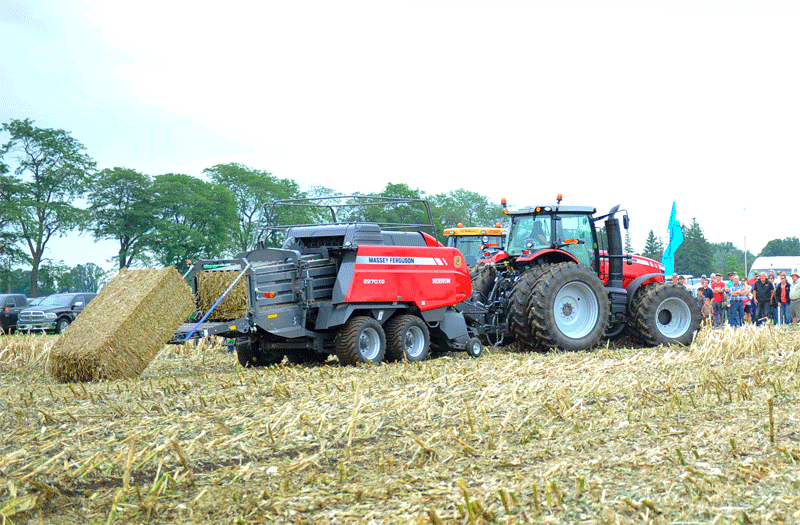A new use for residue
HARVESTING CORN STOVER FOR BIOFUEL
THERE ARE A multitude of uses for corn as an ingredient in a wide variety of foods and household products, livestock feed, and fuel. Much of the time, however, only the corn kernels are harvested for use, leaving corn stalk residue on the field.
PHOTO: CORN STALK HARVESTING DEMONSTRATION AT CANADA’S OUTDOOR FARM SHOW.

Although keeping stalks on the field post-harvest is beneficial, studies have revealed removing some material may actually increase yields while producing extra income for the farmer. Corn stover is slow to decompose, which can impact seed placement and wear on equipment during field work the following year. Studies show that removing up to 30 per cent of corn stover can increase yields in a corn-on-corn rotation.
Research projects relating to corn stover are underway by various industry members and there are increasing talks of harvesting corn stover for processing into cellulosic sugar for use in bio-based products such as biofuels.
ADDING VALUE
“One of the benefits I see is adding value to a crop we already grow,” says Dave Park, Grain Farmers of Ontario District 3 (Lambton) director. “Any time farmers have the opportunity to increase the value we get per acre for a commodity without increasing our land base is very attractive. Another potential benefit I see is the opportunity for farmers to get back to true no-till. Recently, with increased corn yields, populations and hybrids have been bred for increased standability and we’re left with more residue on the corn field post-harvest than ever before.”
However, there can be consequences to removing corn stover as well. Removing stover also means the removal of nutrients and leaving the surface more susceptible to erosion. In Ontario, approximately four tonnes of residue per acre are needed to maintain organic matter, so farmers interested in harvesting their corn stover must be aware of how much they are taking off the field. Other issues include equipment needed to bale, transport, and store the stover, and the costs associated with each.
NUTRIENT LOSS
According to Pat Lynch, Certified Crop Advisor (CCA), it is important to minimize nutrient loss in the field when harvesting corn stover.
“The longer the stalks stay in the field the less the nutrient loss, for the soil” says Lynch. “If stalks are harvested in the spring they will contain less fertilizer nutrients than if harvested in the fall right after grain harvest.”
“Today’s hybrids produce a lot more organic matter than hybrids of 20 or even 10 years ago,” says Lynch. “While harvesting corn stalks will remove organic matter, there will still be a lot of organic matter left. Even when you remove part of the corn crop for stover there will be more organic matter returned than with soybeans or wheat.”
Lynch suggests limiting your soybean rotation, including red clover in wheat rotations, and using conservation tillage on corn stalks to mitigate the loss of organic matter. However, all factors considered, farmers grow corn as a “cash crop” and if a farmer can sell corn stalks for a profit, they should, reminds Lynch.
COMPACTION
It is also important to minimize compaction when harvesting. Not harvesting when the ground is extremely wet and waiting until the ground is frozen can reduce soil compaction. Machines with tracks can also cause less compaction than equipment with tires.
In an effort to reduce worries about increased compaction, equipment has been developed to minimize the amount of activity in the field to harvest stover. This year, Canada’s Outdoor Farm Show included corn stalk harvesting demonstrations for farmers interested in learning more about the equipment. The AGCO 2014-2270 XD large square corn stalk baler, a Hiniker flail chopper, and a Stinger 6500 bale stacker were showcased in a two- pass system.
“I was encouraged to see the ease of which the equipment turned a three-pass job of shredding, windrowing, and baling into a two pass job,” says Park. “I liked how these are proven technologies and we’re not being asked to re-invent the wheel.”
FUTURE USE
Sarnia, within Park’s district, already has a large existing chemical industry, making it a potential location for a cellulosic sugar plant. Stover could readily be sourced from the surrounding counties of Lambton, Huron, Middlesex, and Chatham-Kent, where corn yields can exceed 150 bushels per acre. Park says, “having some of the stover removed in the fall could help warm the soils quicker in the spring, allowing us to get our soybean planters moving earlier on in the year and ultimately increasing our soybean yields.”
Park thinks harvesting corn stover could be a popular choice for farmers and sees potential in adding another revenue stream to a crop many farmers in Ontario are already currently growing.
“Ultimately it will come down to two issues — the economics and the agronomic impact to the farmer. The big questions farmers will be asking is ‘is it sustainable?’ and ‘does it pay?’ Personally, I think the answer to those questions will be yes.”
SINGLE-PASS SYSTEM
Hillco Technologies, Inc., in partnership with John Deere, has developed a new system for harvesting corn and baling corn stover.
The Hillco Single Pass Round Bale System (SPRBS) harvests corn and bales corn residue in a single pass, maximizing efficiency and productivity and minimizing costs. While other corn stalk balers are a separate machine that bales the stalks after the field has been harvested, the SPRBS is pulled behind the combine. This decreases ash and dirt content in the bales compared to other systems, while removing a lower amount of essential nutrients from the soil.
The SPRBS is fully automated and continually produces round bales without stopping. Bales consist of a high percentage of cobs and husks to ensure optimal moisture levels. The SPRBS has minimal impact on corn harvest efficiency and speed, and has low horsepower and fuel consumption.
For more information on the Hillco Single Pass Round Bale System, see your local John Deere dealer or visit www.hillcotechnologies.com. •







